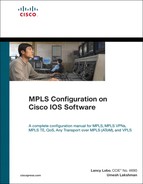Carrier Supporting Carriers Overview
Carrier supporting carriers (CSC) is implemented in circumstances in which one service provider needs to use the transport services provided by another service provider. The service provider providing the transport is called the backbone carrier and the service provider using the services provided by the backbone carrier is called a customer carrier. The customer carrier can either be an ISP provider or an MPLS VPN service provider.
Figure 8-1 shows a network topology in which ISPX is the customer carrier and has two POP sites, ISPX-POP1 and ISPX-POP2.
The customer carrier ISPX is using MPLS VPN services provided by the backbone carrier to route traffic between user sites. In the CSC model, the links between the backbone and customer carrier are MPLS enabled to provide an end-to-end LSP path between the two POP sites located in the customer carrier network. In the CSC model, the backbone carrier providing MPLS VPN services to the customer carrier has knowledge of only the customer carrier’s internal routes. These routes are relevant for building the LSP path between the two POP sites and for forming the iBGP or MP-iBGP session between the POP sites. User networks will then be transported across this iBGP or MP-iBGP session.
Label Exchange Methods in CSC Architecture
There are two ways of exchanging IGP labels in an MPLS VPN network:
Using IGP for label exchange
Using BGP for label exchange
Using IGP for Label Exchange
This method employs the traditional approach of using an IGP to exchange routes between PE-CE routers. Label exchange is performed using TDP/LDP protocols. Figure 8-2 shows the configuration steps for enabling MPLS on PE-CE routers.
Using BGP for Label Exchange
In this method, BGP is used for routing and for label exchange. When using EBGP for label exchange, mpls bgp forwarding is automatically configured under the interface. Prior to that, ensure that TDP/LDP Protocol (mpls ip) is not enabled on the interface.
Figure 8-3 shows the steps to configure BGP for IPv4 label distribution.
Note
Check Cisco.com for IOS versions supporting this method.



